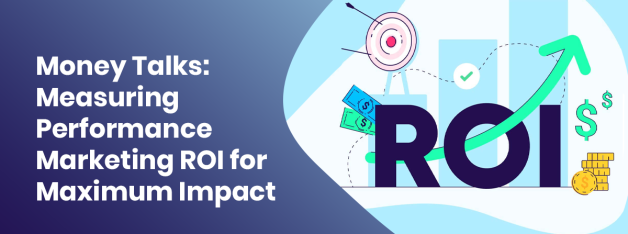Money Talks: How to Measure ROI for Performance Marketing for Maximum Impact

A marketing campaign feels like playing an intricate game of chess: Plan, make your moves, and wait to see if it pays. The ROI of your campaigns is the secret to winning. With the numerous marketing channels and various target audiences today, understanding more on what works and what doesn’t is more imperative now than ever when measuring return on investment.
We’re going to break down strategies for measuring performance marketing ROI so you can walk away with actionable insights to maximize your impact in this blog.
Why Measuring ROI Matters
Imagine running a marathon without knowing the distance or time—you may exhaust yourself not knowing how good you did it. Similarly, a marketing campaign may waste resources because ROI tracking measures the direct contribution of your marketing strategies to your business success.
Key Benefits for Measuring ROI:
- Data-driven insights: which campaign is driving the results and needs optimization.
- Budget Optimization: invest in high-performing strategies while cutting unnecessary expenses.
- Long-term planning: It has to be built on proven success metrics.
For example, after analyzing ROI, a fashion retailer increased its conversion rates by 25% as it reallocated budget to paid social media ads.
Step 1: Define Clear Goals and Objectives
A successful campaign will need a clearly defined destination. Do you need more leads, higher sales or perhaps greater brand awareness? Having clear goals enables easier and better tracking of return on investment.
How to Set Goals
- Set in line with the provided business objectives. Some examples include; “Increase online sales by 20% during Q1.”
- Use KPIs such as cost per lead, customer acquisition costs, and conversion rates.
- Break up large goals into smaller, measurable markers.
Analogy: Imagine the goals as being the GPS of your campaign. You cannot possibly get there unless you input where you want to go.
Step 2: Using the Right Tools to Track
To achieve the true and accurate measure of ROI is to use the right tracking tool. These applications collect data about your marketing channels so that it is possible to monitor performance in real-time.
Top Tracking Tools
- Leading Tracking Tools
- Google Analytics – Website traffic conversion.
- HubSpot – Campaigns managed while evaluating the customer’s journey.
- Hootsuite: Tracks social media performance and engagement.
Example: A SaaS company used HubSpot to see how a specific campaign was going. The reports showed that more ROI was on email marketing campaigns than paid advertisement.
Step 3: Follow the Cost of Campaigns
The revenue is what matters, yet the cost for the campaign counts equally. No one can calculate a profit without finding out the spent amount.
Key Activities:
- Analyzing the expense through the channel by social media, content production, or influencer charge.
- Budgeting tools can be used to remain transparent and avoid overspending.
- Spend-to-return ratios should be compared to determine if the campaign is profitable.
Pro Tip: Periodically revisit budgets to find out whether the campaign will be sustainable in the long term.
Step 4: Effective Calculation of ROI
ROI tells you whether the campaign is a good investment or not. To calculate ROI, you can use this formula:
ROI = (Revenue – Cost) ÷ Cost × 100
For example, suppose a campaign costs ₹50,000 but brings in ₹2,00,000 in revenue.
ROI = (₹2,00,000 – ₹50,000) ÷ ₹50,000 × 100 = 300%
This means that for every ₹1 spent, the campaign earned ₹3.
Step 5: Analyze Conversion Rates
Your conversion rates measure how well your campaign converts visitors to leads or buyers. A bad conversion rate might mean that targeting has not been good enough or the landing pages not relevant enough.
How to Refine Conversion Rate Optimization:
- Streamline website usability and reduce form length.
- Craft attention-getting CTAs, “Get Your Free Trial” or “Download Now.”
- Validate ad creative, headlines, and images to learn what combination works.
Analogy: Conversion rates are like seeds—plant them in fertile soil (effective campaigns), and they’ll grow into a blooming garden of leads.
Step 6: Customer Lifetime Value (CLV)
Short-term wins are great, but CLV focuses on the long term. It calculates the total revenue a customer generates throughout his relationship with your brand.
CLV Formula: CLV = Average Purchase Value × Purchase Frequency × Customer Lifespan
Example: A fitness app determines that each user generates ₹10,000 over two years. With this knowledge, they invest more in acquiring similar high-value customers.
Step 7: Compare Marketing Channels
Not all channels deliver equal ROI. Analyzing performance across channels helps allocate resources more effectively.
How to Compare Channels:
- Review KPIs like ROI, click-through rates, and engagement levels.
- Segment performance by audience type and campaign objective.
- Reallocate budgets to high-performing platforms like Facebook Ads or LinkedIn.
Example: A B2B software company realized that LinkedIn campaigns were performing better than email marketing in terms of lead generation. This led to a reallocation of budget.
Step 8: Utilize Real-Time Data for Adjustments
The beauty of modern marketing is real-time analytics. Don’t wait until the end of a campaign to make changes.
Real-Time Optimization
- Monitor ad spend and ROI daily to identify low-performing ads.
- Tweak targeting or creatives to reflect what audiences are responding to.
- Test creative variations in-flight to get instant and timely feedback.
Step 9: Activate the Feedback Loops
Marketing is a never-ending cycle. Take learnings from post-campaign analysis to inform and enhance future efforts.
Sources for Feedback
- Customer Surveys and Focus Groups.
- Social Media Engagement Trends.
- Internal team reviews of what worked and what didn’t.
Example: An e-commerce retailer used post-campaign analysis to find that product bundles drove more sales than any individual promotion, so the business adjusted its strategy.
Long-Term Advantages of ROI Measurement
Continued measurement of ROI yields long-term advantages for your business:
- Clearer Decision Making: Information informs future investments.
- Sustainable Growth: Concentrated efforts toward high-value strategies will scale.
- Increased Credibility: Data-driven marketing puts your brand in the position to be considered a trusted authority.
Conclusion
Measuring the ROI of your performance marketing campaigns is not just a play with numbers; it rather reveals the impact of every effort made and aligns them with the main objective. With each step from real-time tools to optimizing conversion rates, value is added to the process.
Remember, ROI isn’t just a metric—it’s a mirror reflecting the efficiency of your marketing strategies. Ready to maximize your campaign’s impact? Start tracking today and pave the way for smarter, data-driven decisions.
